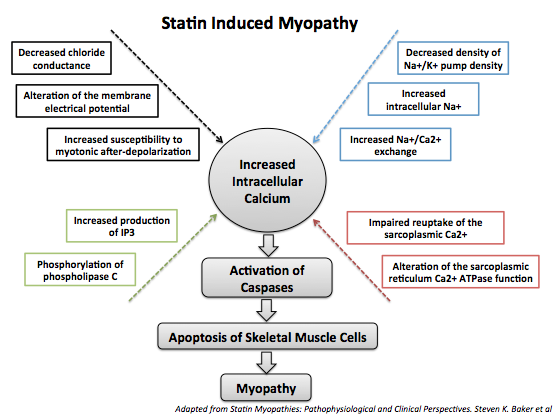Statin induced myopathy pathophysiology
Editor-In-Chief: C. Michael Gibson, M.S., M.D. [1]; Associate Editor(s)-in-Chief: Rim Halaby
|
Statin induced myopathy Microchapters |
|
Diagnosis |
|---|
|
Treatment |
|
Statin induced myopathy pathophysiology On the Web |
|
American Roentgen Ray Society Images of Statin induced myopathy pathophysiology |
|
Risk calculators and risk factors for Statin induced myopathy pathophysiology |
Overview
Statin induced myopathy has a complex poorly understood multifactorial pathophysiology. It is postulated that statin induced myopathy is caused by apoptosis of the skeletal muscle cells due to disrupted intracellular calcium signaling and mitochondrial dysfunction secondary to depletion of mevalonate metabolism products, particularly coenzyme Q10.[1]
Pathophysiology
The following changes are caused by statins:
- Changes in cholesterol content and alteration of the membrane fluidity of the skeletal muscle cells which disrupts their normal function
- Changes in skeletal muscle cells membrane electrical properties
- Changes in Na+/K+ pump density resulting in decreased production of ATP
- Changes in the excitation-contraction coupling
- Changes in the cell surface receptor transduction cascades
- Decreased synthesis of ubiquinone (coenzyme Q10), a component of the mitochondrial electron transport chain, leading to decreased ATP production and decreased free radical scavenging
- Increased intracellular calcium causing apoptosis of the skeletal muscle cells[2]
- Decreased mevalonate metabolism products, particularly isoprenoids, leading to a chain of events that culminate in the apoptosis of skeletal muscle cells[1]
In addition, muscle biopsies of patients suffering from statin induced rhabdomyolysis show a ragged red fibers appearance.[3]
- Shown below is an image depicting the mechanism of statin induced myopathy through increasing the intracellular calcium concentration.

References
- ↑ 1.0 1.1 Dirks AJ, Jones KM (2006). "Statin-induced apoptosis and skeletal myopathy". Am J Physiol Cell Physiol. 291 (6): C1208–12. doi:10.1152/ajpcell.00226.2006. PMID 16885396.
- ↑ Baker, S.K. & Tarnopolsky, M.A. (2001). Statin myopathies: pathophysiologic and clinical perspectives. Clin. Invest. Med., 24(5): 258-272.
- ↑ Mohaupt MG, Karas RH, Babiychuk EB, et al.: Association between statin-associated myopathy and skeletal muscle damage. CMAJ Can Med Assoc J 2009, 181:E11–E18